Photo Credit: Antara Mrinal
Clear Cut Gender Desk
New Delhi, UPDATED: Sep 22, 2025 02:25 IST
Written By: Antara Mrinal
People have studied Marketing for a long time, especially with its incorporation of subconscious tactics. Adverts focus on a person’s self-doubt, amplify it, and then conveniently offer a solution; and no other demographic has been scrutinized and targeted as intensely as women. It is a well known fact that selling to women has a much higher success rate. It is not that women are weak and gullible, but it is their social conditioning, a digitally distorted image of beauty, and socio-political barriers that make women easy targets. From make-up counters to cosmetic surgery, a stream of communication tells women they have a social responsibility to look good. The economics are easy to understand: women make less money, save less, and have a far greater expenditure.
The Wage Gap: A Tilted Playing Field
The start of the story is marked by disparity earnings as per the International Labour Organization (ILO), women on average are still earning 20.7% less than men and the situation has remained stagnant for 2 decades. In 2002, the gap was nearly 20.2%; it grew to 22.6% by 2011 and stubbornly hovered close to 20% in the years to follow. The gap is not restricted to low income countries, as Organization for Economic Co-operation and Development (OECD) data also demonstrates, even high income countries maintain a persistent 17-18% gap. Germany has one of the widest, with women earning 22.8% less than men, followed by India (22%) and the United States (21.7%) is not much better. Even global economic powerhouse Japan has a gap of 19.8%. This isn’t just about dollar. Wages equate to smaller pensions, less assets, and insufficient prospects. OECD reports suggest that in many countries women’s retirement income is 20-40% less than men. A lifetime of career interruptions of caregiving, unequal part-time employment, and unequal financial service access increase the wealth gap. The World Bank’s Global Findex data confirm that women are still less likely to accumulate significant savings than a decade ago, even though more women have bank accounts now.
Markets exploit this vulnerability by offering not financial stability, but products that promise self-worth.

The Pink Tax: Paying More for Less
Women are charged extra for buying the same products men buy. This has been termed the “pink tax”, although it is not a tax. A 2015 study by the New York City Bureau of Consumer Affairs titled “From Cradle to Cane” analyzed over 800 products and found that ladies pay, on average, 7% more than men for the same products, spanning children’s toys, cosmetics, and adult apparel. Gendered pricing is a documented phenomenon confirmed by Consumer Reports and the European Parliament. Over a lifetime, the extra dollars for each product spent invariably constitute a considerable financial loss to a woman adding to their ‘visible’ expenditure. Simply put, women have to pay the additional cost of being women in the marketplace.
The Beauty Economy: Selling Confidence in a Bottle
The extent to which marketing shapes women’s behavior can be seen most vividly through the beauty sector. The globally valued beauty and personal care industry, which was worth $296 – $336 billion at the beginning of the 2020s, is predicted to exceed $500 billion by the 2030s, registering consistent annual growth of 5 – 7% (Grand View Research; Fortune Business Insights). Growth is not only about expansion but also about definition. Entirely new product categories – “skinimalism,” “clean beauty,” “detox supplements,” “micro-needling kits,” “age defying serums” – which did not exist 20 years ago, now do. Each one promises to transform the user, while also reinforcing the idea of the natural body as inadequate. The growth of the beauty industry is starker. The International Society of Aesthetic Plastic Surgery (ISAPS), for example, documented about 35 million cosmetic surgeries globally in 2023, which was an astonishing 40% growth from 2019 – 2023. Women form the overwhelming majority. Once viewed as niche, aesthetic procedures have gained legitimacy due to the influence of social media and influencers. Here, selling is about offering solutions to problems one has created. Ads bombard users with unachievable goals, and then sell products to eliminate the insecurities they have created.
Why Women Buy: Human Behavior and Social Pressures
It’s much easier to understand how persuasion works when you see it in action than when you only study it in theory. Behavioral sciences show how people’s thinking is shaped by certain mental shortcuts, like fearing losses more than valuing gains (loss aversion), wanting things that seem rare (scarcity), and following what others are doing (social proof). Marketers translate these into the most persuasive calls to action.
- Scarcity: ‘Limited edition’ products evoke the ‘fear of missing out.’
- Social proof: ‘Trending now’ induces the ‘bandwagon effect.’
- Personalization: ‘Made for you’ adds the pseudo sense of emotional connection.
Women are often taught to see self-gratification as tied to their looks and social relationships, which makes them the main targets for marketing. Fast fashion cycles, which renew every 7 days, provide a source of ‘newness’ that fuels compulsive and repetitive buying. Social media, a domain of the world where women are predominantly users that engage with lifestyle content, offers an endless supply of carefully tailored images that create a sense of inadequacy as a normative feeling. This does not point towards an individual’s personal weakness, but rather serves as an example of social conditioning. When an entire society equates being a woman with being beautiful, it is that society that gives rise to a market that seeks to benefit from that equation.
Toward Change: Redesigning the Marketplace
All of this contributes to a cumulative effect of women failing to save unknowingly. The wage gap within women is already a disadvantage, and then further losing more due to the “pink tax”. Not to mention the booming beauty economy and the fast-fashion treadmill losing even more. The outcome is to the point: women the moment they retire have 40 percent less wealth due to the pension gap within OECD. The reality within women of aged societies is even more dire: financial insecurity when old. The price of this situation is no longer simply economical. The emotional suffering of upkeep – constant comparison, irregular beauty-reinforcing drills and the burden of ‘holding the fort’ – merely elevates the workload. What is termed “consumption,” and viewed as a form of empowerment, is in fact, a spiral of projection of market capitalization on the women consumers.
However, this dynamic isn’t a foregone conclusion. Policy initiatives can alleviate the structural inequities: end gender-based pricing to eliminate the ‘pink tax’, increase transparency in promotional materials and product labeling, provide women-centered financial education and targeted savings plans, defy damaging appearance stereotypes through authentic media representation, and most importantly, citizens can shift how they perceive agency: purchasing the latest serum is not a sign of empowerment, but understanding how the system works to make such a purchase feel indispensable.
With inputs from:
- International Labour Organization, Global Wage Report (2020, 2022)
- OECD, Gender Wage Gap Indicator (2023)
- OECD, Pensions at a Glance (2023)
- NYC Department of Consumer Affairs, From Cradle to Cane (2015)
- ISAPS, Global Survey on Aesthetic/Cosmetic Procedures (2023)
- Grand View Research & Fortune Business Insights, Cosmetics Market Reports (2024)
- Dove, Self-Esteem Project & Global Beauty Confidence Reports




